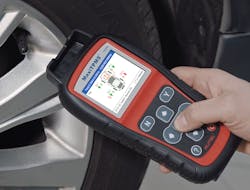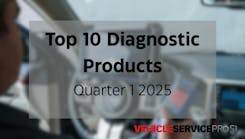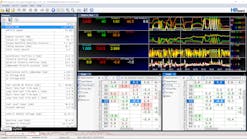A complete tire pressure monitoring system (TPMS) service includes the ability to diagnose, test, repair, and reprogram vehicles’ TPMS components. Automotive shops providing TPMS services need tools to help accommodate different vehicle makes and models, most of which require unique procedures, software, or equipment for servicing. When technicians understand the benefits of TPMS service and are aware of emerging technology and trends within the category, they don’t have to fear turning business away. Instead, they can remain relevant – and profitable – with this service.
The demand for TPMS servicing
TPMS is a growing system on vehicles. Since the federal mandates requiring TPMS on vehicles manufactured after September 2007 went into effect, the category has continuously expanded and evolved.
“Introduced back in the 2004 – 2006 era, we are now a good 15 years into TPMS,” says Michael Flink, national trainer, professional tool level sales manager, Autel. “We are finally reaching the long-promised period in which people said the sensors were going to go bad and we will need to service the cars.”
Flink mentions that the promised timetable kept expanding, first quoted at three years, then five; however, reality dictated that the sensors required replacement service around the seven- to ten-year range.
“Shops are running into customer complaints with the TPMS light being on, then have to diagnose and deal with [the sensors],” Flink says.
“Before TPMS, when you got a new set of tires, what did you get? A new set of rubber valve stems,” says Scot Holloway, CEO and general manager, Bartec USA. “TPMS is really one of the few ways a tire retailer can actually grow their bottom line. There are more opportunities for service. If a tire retailer has a complete TPMS service program in place, they have the ability – for every TPMS equipped vehicle that comes in – to service the sensors on those vehicles.”
When sensors are serviced, technicians may need to remove the wheels and the tires, clean the wheels, and also replace seals, stems, cores, caps, or the entire sensor units themselves. All of this presents an opportunity to upsell and improve both the bottom line and service.
The tools
The lynchpin of TPMS servicing is the diagnostic tool, which is used to scan, diagnose, and reprogram the sensors, as well as write sensor IDs to the vehicle’s ECU. There are many variations available today in terms of capabilities and features. Selecting the right tool for the needs of the shop and technicians is crucial.
ATEQ TPMS Tools offers the VT56, a comprehensive TPMS service tool with coverage of American, European, and Asian vehicles.
“The VT56, is built to last at least 10 years,” says Sheila Stevens, aftermarket account executive, ATEQ TPMS Tools. “[Technicians] don’t have to worry about discontinued tools or needing the new-to-market tools. They can trust in their dealers providing quality products that will evolve with them and the times.”
The VT56 features ATEQ’s patented Sync ID technology, which allows technicians to reset vehicles by connecting through the OBD-II port.
“It’s an easy sell because when you reset a vehicle, there are hundreds of different relearn procedures, [depending on the year, make, and model],” Stevens says. “There are a lot of different steps to take and it’s a pain. So instead of having to memorize the many different relearn procedures, we came up with Sync ID that will allow the OBD-II to reset domestic vehicles as well. [Technicians] can plug into the OBD-II and memorize one relearn process instead of hundreds.”
The VT56 also features a VIN scan. The VIN scan identifies the vehicle’s year, make, and model in seconds, saving technicians time. The tool can also retrieve TPMS DTC codes on select vehicles, has RKE testing functionality, programs leading aftermarket programmable sensors, has OE and aftermarket sensor part number look-up, can save service history onboard and on a PC, and has over 23 languages. The VT56 also has a placard pressure adjustment feature. This allows the tool to change the vehicle’s ECU’s tire pressure designation; when a vehicle is being equipped with different tires, such as snow tires, truck tires, or low-profile tires that require a change in PSI, the VT56 can tell the vehicle the new PSI levels so that the monitoring system is accurate and in line with the new PSI profile.
Autel offers the MaxiTPMS TS508. The newest TS508 model features Wi-Fi capabilities, which can update the tool through a Wi-Fi internet connection rather than having to utilize a PC. The TS508 has OBD-II relearn capabilities, removing the need to memorize the various relearn-engagement procedures. The TS508 is also capable of placard pressure adjustments. According to Autel, the TS508 can activate all known TPMS sensors, as well as read sensor status, program sensors, and perform relearns.
Autel also offers the MaxiTPMS TS608, a mini-tablet style unit. Beyond the TPMS features that the TS508 offers, the TS608 also contains service functions similar to Autel’s MaxiCheck MX808 tool. The TS608 can perform procedures such as oil light reset, steering angle reset, ABS bleeds, electronic parking brake functions, battery maintenance resets, and more. The TS608 can also do basic diagnostics of reading and erasing codes.
“The TS608 offers a more complete service and TPMS tool in one unit,” Flink says.
Bartec USA offers the Tech400Pro, which comes with extensive vehicle coverage. The Tech400Pro also has OBD-II relearn capabilities to facilitate a quicker and simpler relearn process. The tool is capable of placard adjustments to set the PSI in the vehicle’s ECU accurately and in line with the appropriate levels when new tires are placed on a vehicle.
“If you are ahead of the curve as a tire retailer, [placard adjustment] is something you can bake into the price and charge for, because not everybody can do it,” Holloway says.
The Tech400Pro is Wi-Fi updateable. The tool can be set to check for updates automatically and install available updates on its own when connected to a Wi-Fi internet connection, allowing technicians to "set it and forget it." The Tech400Pro is compatible with aftermarket sensors, can send reports through Bluetooth connections, has inductive wireless charging capabilities, and has a removeable SD card for updating without an internet connection.
Programmable sensors
Aside from the service tools, sensors are the other major component of the TPMS system. Programmable sensors have taken the category by storm with their ability to compensate for the need to stock a variety of SKUs with a range of sensors.
“Direct TPMS is going to be the most accurate way to determine the condition of the tire pressure,” Holloway says. “It’s a computer, inside the wheel, sending out its data via an RF signal. We partnered with Schrader TPMS Solutions early on with the development of EZ-sensor.” EZ-sensor is a single SKU programmable replacement sensor.
Autel offers the MX-Sensor 1-Sensor, a programmable universal sensor. The 1-Sensor can handle everything from passenger vehicles through one-ton, larger vehicles.
“Larger shops aren’t going to buy all their sensors from the dealer, but the tool along with the sensors can be an enticing sale,” Flink says. “Smaller shops may not have a great source for sensors, so they can be an additional, kind of razor-and-razor-blade sales scenario for the dealer that gets the tool in the shop. We do offer a bulk 20-count box of the loose sensors; if a dealer gets enough of these sales, they can get that box on the truck and give themselves additional sales and revenue.”
Shops with both TPMS service tools and programmable sensors can service most vehicles that enter their bays. Flink says many of their tire service industry customers with the tool and programmable sensors combination report that they no longer send work to dealerships for TPMS service.
Security, access, and compatibility
An emerging trend in the automotive manufacturing industry is the implementation of security gateway modules. These modules were introduced to protect malfeasances from entering the OBD-II port and subsequent tampering with the vehicle’s ECU or other components. Fiat Chrysler Automobiles (FCA) has included such a gateway module on select vehicles manufactured in 2018, and on even more models in their 2019 line. The security gateway module acts as a firewall, and many TPMS or scan tools that utilize OBD-II connections may be blocked from communicating with a vehicle that has such a module.
“If you’re not an OE dealer, a TPMS tool is not going to be able to communicate through their system,” ATEQ’s Stevens warns. “You’ll be able to read the sensors, but as far as resetting the vehicle, it’s not going to happen if you can’t communicate through the OBD-II properly. In order to properly communicate through the OBD-II, you have to be either a dealer tool, or get blessed by FCA if the tool is not a dealer tool.”
The list of approved TPMS tool manufacturers is short, so it is crucial to check with the tool manufacturer regarding their ability to access FCA’s security gateway module. The industry’s sentiment is that other vehicle manufacturers will follow suit and implement their own security gateway modules on the OBD-II and other ports of entry.
“It’s certainly drastic for the aftermarket,” says Bartec’s Holloway. “If anything, those [modules] are going to get more robust because there have been those able to ‘hack’ vehicles through the OBD-II.”
Another security aspect relates to the tool itself.
“What has the tool manufacturer done to keep the tool from being hacked?” Holloway asks. “Our tool, for example, has Wi-Fi hardware in it, which means it connects to your shop’s Wi-Fi connection, which may be connected to your network or other secure pieces of hardware. What have the manufacturers done for the tool to maintain the security? We take that pretty seriously.”
Bartec USA addresses this through its software, which meets the International Organization for Standardization’s ISO/IEC/IEEE 90003:2018 standards.
Stay up to date
Software updates for TPMS tools are integral, as they allow the tools to stay up to date on industry changes. Programmable sensors adding new makes and models, tools offering new features or extended vehicle coverage, and vehicle manufacturers implementing security modules and the subsequently granting or blocking of a tool’s access to a vehicle’s ECU will all affect a tool’s ability to service select vehicles. However, these issues can be overcome through software updates.
Some tool manufacturers charge subscription fees for software updates, while others offer free updates. Discuss with a shop owner their needs, such as how much TPMS services they provide and their need for up-to-date software. A tool with current software allows shops to service more vehicles and limit the instances in which they turn customers away.
“It is very hard for dealers to be able to provide a ton of aftersales support, so they want to make sure that the manufacturer they are buying from has a lot of material out there to be able to help when a dealer is unable to,” ATEQ’s Stevens says.
With such a large product offering, a dealer may not be an expert in TPMS equipment, so having the ability to utilize provided information on the tools and their services and functions is important. ATEQ has their own YouTube channel, a blog, bi-weekly emails, and training sessions to provide insight on troubleshooting tips and tool information.
Having information inside of the tool is another avenue of support.
“Different vehicles are constantly changing how that relearn is done, so technicians need access to that information. Simply having it in the tool helps; a step-by-step guide will guide the technicians through that process,” Autel’s Flink says, speaking on the abilities of the TS508 and TS608.
Autel has a YouTube channel, support line, and live chat to provide resources for technicians and dealers alike.
Bartec also has the relearn procedures built into their tool, as well as part number look-up features and the Tire Industry Association chart with page references. Their website features videos on updating the tool, activating sensors, and certain aspects of the tool’s functions. The videos are short so users can pick up a new skill or obtain the information they were seeking quickly and return to the shop floor to continue service.
Display, demonstrate, and sell
“The first thing a dealer should do is take a look around the shop they are visiting,” Autel’s Flink says. “Is there a tire machine in the shop? If there’s a tire machine in there, you know they have a guaranteed need for TPMS tooling.”
Understand the needs of the shop and its technicians when selling TPMS tools and equipment. Don’t assume that since a shop is buying sensors from a tire supply warehouse or a parts store they do not need a tool. Some sensor manufacturers give a free tool with their sensors, but those tools can be limited in their coverage, features, and functions. Shops may be looking for a more complete tool to round out their offerings.
“Ask what their needs are,” ATEQ’s Stevens says. “What vehicles do you work on? What issues are you having with TPMS? Are you turning customers away to the dealership for TPMS service? What sensors do you work with?”
The answers to these questions will unveil both the needs of the shop and the right tool for their technicians.
Display TPMS tools alongside diagnostic tools in the truck. This is a good way to get potential customers to pick up the tool and investigate. Some TPMS tools have a colorful, brightly lit display; tool manufacturers suggest having the tool turned on to attract the technicians and welcome them to navigate the platform.
The Tech400Pro’s accessory wall-mounted cradle with induction charging can double as an excellent display.
“If a dealer has the wall space on the truck, hang the tool,” Bartec’s Holloway says. “Put it up there, show it in action, plug it in, show how it works, and be ready to demonstrate it.”
The best way to encourage the purchase of a TPMS tool is to show that tool in action through demonstration. Stevens, Flink, and Holloway all suggest having programmable sensors on-hand to demonstrate the tool; or if a dealer is so inclined, get out of the truck and initiate and complete a relearn process on the truck itself, or even a vehicle in the shop’s lot.
Stay relevant
Finally, “Make sure you pick a tool that you can make money with,” Bartec’s Holloway says. “That seems obvious, but if you can’t use the tool, can’t get access to a car, or it doesn’t have the coverage that was implied … or if you don’t have good technical support, is that tool helping you make money?”
The TPMS category is extensive, and with such vast variations in functions, capabilities, and coverage, selecting the proper tool can seem challenging or overwhelming. As a dealer, you can smooth this process by communicating with tool manufacturers, shops, and technicians, so that your customers understand each tool’s capabilities and they can select the tool that meets their needs. Helping shops and their technicians stay current with industry trends, changes in technology, and ever-increasing demand for TPMS servicing will set you apart from the rest.



